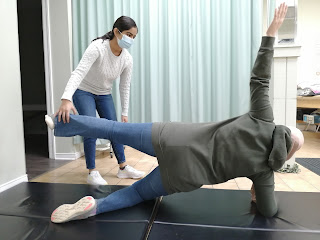Soft Tissue Injury
Soft Tissue injury
1. Muscle Strain
A stretch, tear, or rip to a muscle or an adjacent tissue that can range from a mild tear to complete muscle rupture and usually involves large force producing muscle.
Healing time may depend on the level of severity of the injury which are
as follows:
Grade I
Some muscle fiber tearing
• tenderness and painful movement
but full range present
Grade II
Many torn muscle fibers
• active contraction is painful, usually a depression or divot is palpable, some swelling and discoloration result
Grade III
Complete rupture of fibers
• significant impairment
initially with a great deal of pain that diminishes due to nerve damage
Muscular pain may be a result of:
Muscle spasms or guarding are the reflex reactions caused by trauma.
There are two types which are as follows:
Clonic - Alternating involuntary muscular contractions and relaxations
in quick succession
Tonic - Rigid contraction that lasts a period of time
To prevent muscle spasms, a splint may be used as an effort to minimize
pain through limitation of motion.
Muscle soreness is the overexertion in exercise or unaccustomed
activities resulting in muscular pain
Two types of soreness
1) Acute-onset muscle soreness
(AOMS)
- Transient muscle pain and fatigue immediately after exercise
2) Delayed-onset muscle soreness
(DOMS)
- Pain that occurs 24–48 hours
following activity that gradually subsides (pain free 3–4 days later)
- Slight microtrauma to muscle or
connective tissue
Muscle soreness is prevented with a gradual buildup of the intensity of
exercise.
2. Tendon Strain
Caused by collagen re-absorption which occurs with repeated microtrauma
resulting in weakening tendons. Collagen re-absorption also occurs with
immobilization which weakens the tissue and requires gradual loading and
conditioning.
The inflammation or irritation of a tendon — the thick fibrous cords
that attach muscle to bone. The condition causes pain and tenderness just
outside a joint.
While tendinitis can occur in any of your tendons, it's most common
around your shoulders, elbows, wrists, knees, and heels.
Tendinitis should be properly addressed as it is linked to other
complications such as:
Tendinosis
The poor healing of tendinitis - degenerates and results in tendinosis.
Visibly, it will become less inflamed and more swollen, sometimes a tender lump
will appear. Tendinosis causes stiffness and a restriction on motion
Tenosynovitis
Inflammation of synovial sheath which ranges from acute cases (rapid onset, crepitus, and diffuse swelling) to chronic cases (thickening of tendon with pain and crepitus). This is common in long flexor tendon of the digits and the biceps tendon.
3. Ligament Sprain
A result of traumatic joint twist that causes stretching or tearing of
connective tissue
Pain level depends on the ligament sprain grade:
Grade I
·
Some pain, minimal loss of function, no
abnormal motion, and mild point tenderness
Grade II
·
Pain, moderate loss of function,
swelling, and instability with tearing and separation of ligament fibers
Grade III
·
Extremely painful, inevitable loss of
function, severe instability and swelling, and may also represent subluxation
How do I treat my injury?
A mix of rest and light or supervised exercise instructed by a therapist
As with most injuries, it’s natural for an individual to stop moving the injured area and wait for it to heal. Ironically, this is counterproductive. Restricting movement causes the tissue to weaken, become less flexible and receive less circulation. In fact, gentle stretching and exercise is the best way to resolve the injury by getting it moving and increasing circulation.
Hypersensitive nodule within tight band of muscle or fascia after
injuries or overuse. These sensitive areas are called trigger points. A trigger
point in a muscle can cause strain and pain throughout the entire muscle.
An injury may have active or latent trigger points:
• Active = pain at rest
• Latent = pain with pressure
During myofascial release therapy, the therapist locates myofascial areas that feel stiff and fixed instead of elastic and movable under light manual pressure. These areas, though not always near what feels like the source of pain, are thought to restrict muscle and joint movements, which contributes to widespread muscle pain. The focused manual pressure and stretching used in myofascial release therapy loosen up restricted movement, leading indirectly to reduced pain.
Written by Karen Nasr (Kinesiology student at York University)






Comments
Post a Comment